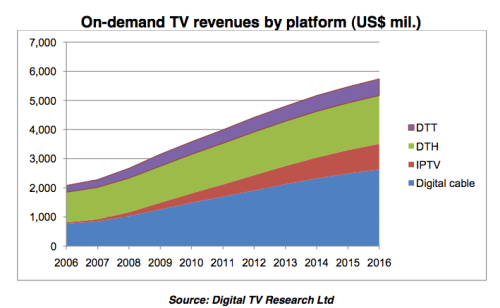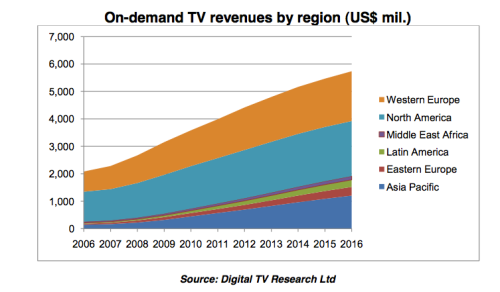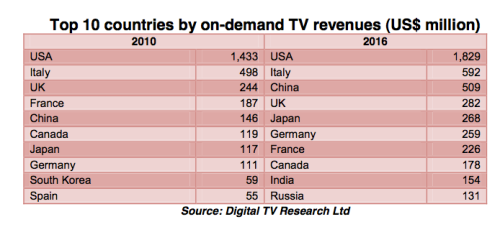
Video On Demand TV revenues from movies and TV programs (and excluding revenues from other sources such as sports and adult and also excluding SVOD packages) will reach US$5.7 billion in 2016, up from US$3.6 billion in 2010 and US$2.1 billion in 2006, according to the On-demand TV Forecasts report published by Digital TV Research.
By platform, digital cable will generate US$2.6 billion in 2016, almost double the US$1.5 billion recorded in 2010. DTH will remain the second largest contributor, with US$1.7 billion revenues in 2016. However, the gap between the two platforms will widen over the next five years. IPTV will overtake DTT in 2012 to become the third largest platform. DTT on-demand revenues are mainly confined to Western Europe, especially Italy.
Much emphasis has been placed on on-demand services making up the operators’ shortfall in declining TV subscription revenues as homes converted to bundled packages and as greater competition leads to lower fees. On-demand TV revenues will grow, but not fast enough to compensate for this decline.”
Murray continued: Free on-demand has attracted much attention as this catch-up provision acts as a customer retention tool. There is little evidence to suggest that these free services actually encourage subscribers to pay for on-demand titles. In fact, it may be harder to convince households to pay for on-demand services if they have become accustomed to receiving free on-demand titles.
Consumers can also catch up with missed programs via the internet. Web-based catch-up services are often easier to use than TV-based ones, allowing the viewer greater flexibility and a better environment to select. TV-based services will improve as smart sets become more commonplace.
Some have advocated that the provision of a large pool of on-demand titles plus the rapid take-up of connected sets will accelerate the demise of linear channels.
improvement, the most vulnerable linear channels to the adverse affects of ondemand are those that rely heaviest on reruns. Channels providing the freshest content will remain the most popular.
By region, North America and Western Europe will still supply two-thirds of global on-demand revenues by 2016, though this is down from 80% in 2010. However, on-demand TV revenues will triple in the Asia Pacific region over the same period to reach US$1.2 billion. China will provide a lot of this growth.
-
Suche starten!
-
Neueste Beiträge
- Download SCHLUSSAKKORD (1960) Full Free Online
- Download UNSER DOKTOR IST DER BESTE Full Free Online | Video On Demand
- Download BLAU BLÜHT DER ENZIAN 1973 Full Free Online | Video on Demand
- Video-On-demand TV revenues to climb 58%
- Prime Time gewinnt mit der Apella Invest AG neuen Kooperationspartner
- Video-Plattform ORF-TVthek startet am 16. November
- Vodafone Videoangebot für alle
- Video on Demand erst in einigen Jahren lukrativ?
- MPEG LA aktualisiert AVC-Patent-Portfolio-Lizenz – Änderungen gleichen Lizenzrahmen an Überarbeitung des AVC/H.264-Standards an
- Ende 2008 hatten 536.000 Kunden Internet-Fernsehen im Abo
-
Links


